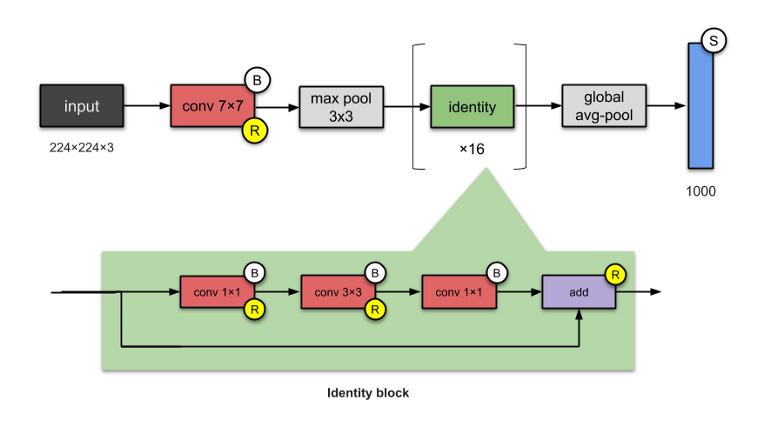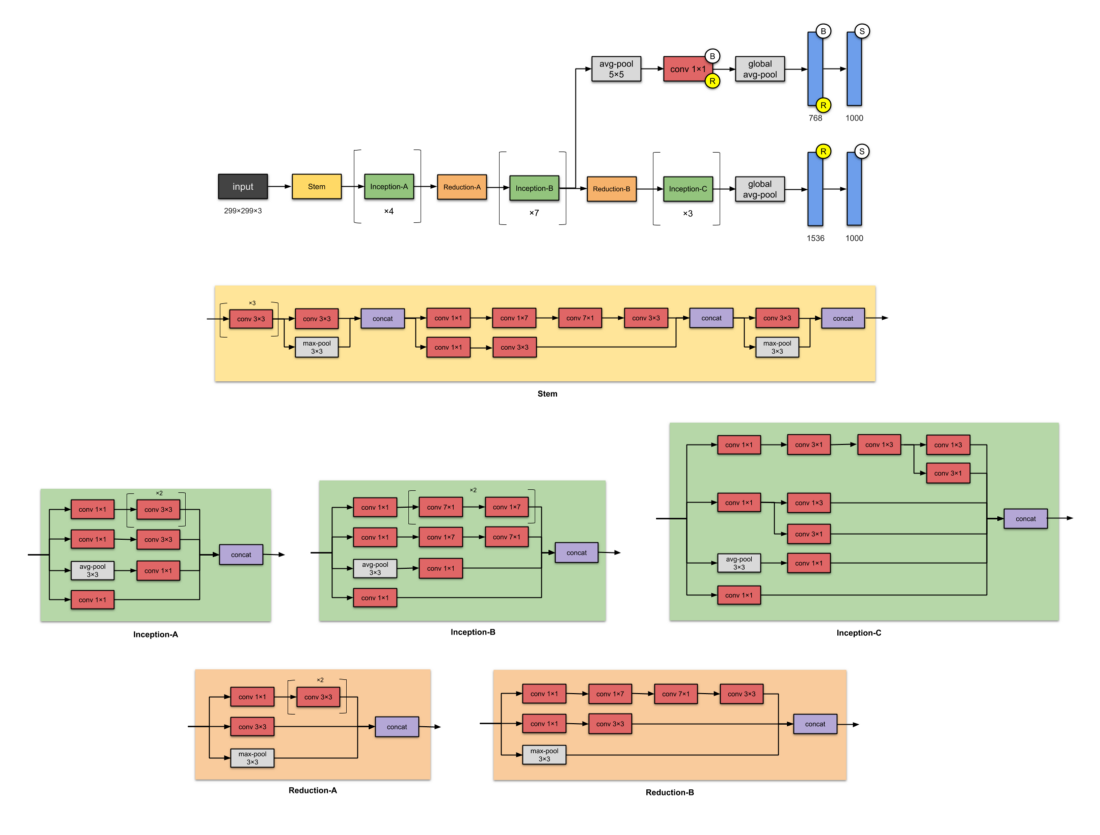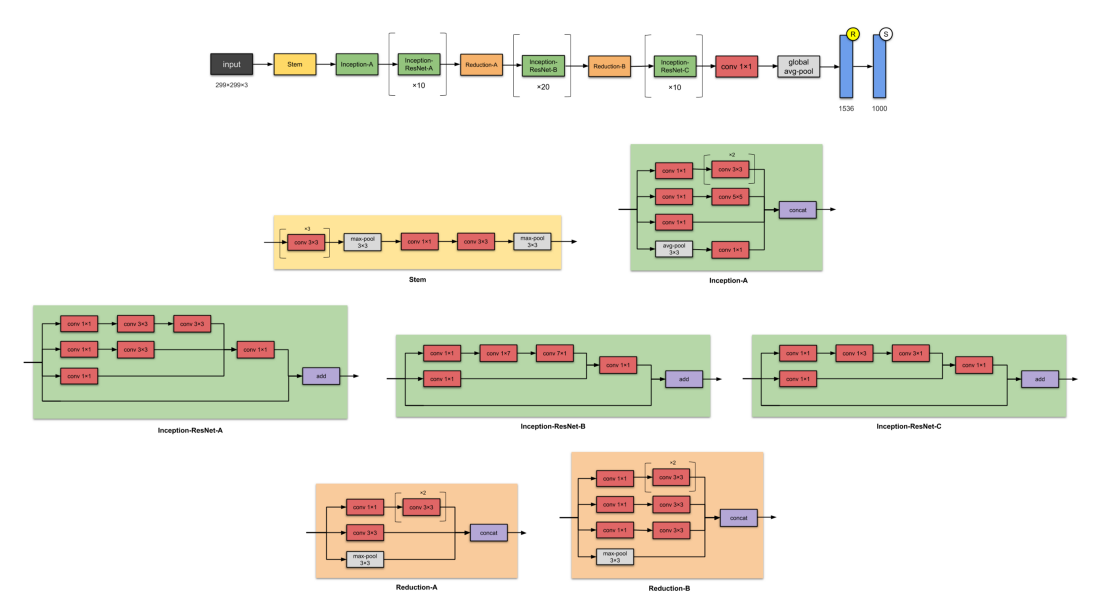图解十大CNN架构(下)
2019年10月03日 由 sunlei 发表
428191
0
6. ResNet-50 (2015)
[caption id="attachment_45064" align="aligncenter" width="1100"]
 ResNet-50 网络架构[/caption]
ResNet-50 网络架构[/caption]对,这就是对文章开头问题的回答。
在上面的几个 CNN 中,我们只是看到设计时增加了层数,就达到了更好的性能。但是,“网络深度不断增加,精度达到了饱和(这一点并不奇怪),因此网络性能开始快速下降”。微软研究院的专家在构建更深的网络时,采用 ResNet ( 残差网络 ) 解决这个问题,可以不再采用全连接的方式。
ResNet 是最早采用批量正则化( Ioffe 和 Szegey 在2015提交给 ICML 的批量正则化论文)的网络之一。上图中是 ResNet-50 的网络架构,采用了 26 M 个参数。
ResNet 的基本建构单元是 conv 层和识别板块。因为它们看上去很相似,你可以把 ResNet 简化成下图:

有哪些创新?
- 大量避免使用全连接(他们不是第一个这么做的)。
- 设计更深的 CNN 网络(最大可达 152 层),而不必损失网络的生成能力。
- 首先采用批量正则化的网络架构之一。
相关论著
- 论文: Deep Residual Learning for Image Recognition
链接:https://arxiv.org/abs/1512.03385?source=post_page
- 作者: Kaiming He, Xiangyu Zhang, Shaoqing Ren, Jian Sun. Microsoft
- 发表在: 2016 IEEE Conference on Computer Vision and Pattern Recognition (CVPR)
7. Xception (2016)
[caption id="attachment_45066" align="aligncenter" width="1100"]
 Xception 网络架构 注:深度可分解卷积用 conv sep 指代[/caption]
Xception 网络架构 注:深度可分解卷积用 conv sep 指代[/caption]Xception 是 Inception 网络结构的一个应用,其中 Inception 模块被替换成深度可分解卷积。它和 Inception-v1 有大致相当数量的参数(23M)。
Xcpetion 采用了对 eXtreme 的 Inception 假设:
- 首先,交叉信道(或交叉特征图)相关性可以被 1×1 卷积探测到。
- 因此,每个信道的空间相关性可以通过常规的 3×3 或 5×5 卷积探测到。
把这个思想推到极致,意味着对每个信道进行 1×1 卷积,对每个输出进行 3×3 卷积。这等同于将 Inception 模块替换成深度可分解卷积。
有哪些创新?
完全基于深度可分解卷积层,引入 CNN。
相关论著
- 论文: Xception: Deep Learning with Depthwise Separable Convolutions
链接:https://arxiv.org/abs/1610.02357?source=post_page
- 作者: François Chollet. Google.
- 发表在: 2017 IEEE Conference on Computer Vision and Pattern Recognition (CVPR)
8. Inception-v4 (2016)
[caption id="attachment_45067" align="aligncenter" width="1100"]
 Inception-v4 网络架构 这个 CNN 有两个辅助网络(在推理时会被丢弃)。注: 所有卷积层采用 batch norm 和 ReLU 激活[/caption]
Inception-v4 网络架构 这个 CNN 有两个辅助网络(在推理时会被丢弃)。注: 所有卷积层采用 batch norm 和 ReLU 激活[/caption]Google 的研究人员再次提出了 Inception-v4(43M个参数)。这是对 Inception-v3 的一次改进,主要的差别是 Stem 组和对 Inception-C 模块的小改动。该论文的作者也“对每种网格大小的 Inception 板块增加了 Uniform 选择”。他们也提到采用“残差连接可以大幅度提高训练速度”。
总之,值得注意的是,论文提到 Inception-v4 因为模型规模增大效果更好。
与之前的 Inceptio-v3 版本相比,有哪些改进?
- 改变了 Stem 模块。
- 增加了更多的 Inception 模块。
- 采用了 Inception-v3 的 Uniform 选择,意味着在每个模块中采用了相同数量的过滤器。
相关论著
- 论文: Inception-v4, Inception-ResNet and the Impact of Residual Connections on Learning
链接:https://arxiv.org/abs/1602.07261?source=post_page
- 作者: Christian Szegedy, Sergey Ioffe, Vincent Vanhoucke, Alex Alemi. Google.
- 发表在:Proceedings of the Thirty-First AAAI Conference on Artificial Intelligence
9. Inception-ResNet-V2 (2016)
[caption id="attachment_45068" align="aligncenter" width="1100"]
 Inception-ResNet-V2 网络结构。注:所有卷积层采用 batch norm 和 ReLU 激活[/caption]
Inception-ResNet-V2 网络结构。注:所有卷积层采用 batch norm 和 ReLU 激活[/caption]在提出 Inception-v4 的同一篇论文中,作者们也提出了 Inception-ResNet:Inception-ResNet-v1 和 nception-ResNet-v2 网络系列,v2 系列有 56M 个参数。
与之前的 Inception-v3 版本相比,有哪些改进?
- 把 Inception 模块转换为残差 Inception 模块。
- 增加了更多的 Inception 模块。
- 在 Stem 模块后面,增加了一种新型的 Inception 模块(Inception-A)。
相关论著
- 论文: Inception-v4, Inception-ResNet and the Impact of Residual Connections on Learning
链接:https://arxiv.org/abs/1602.07261?source=post_page
- 作者: Christian Szegedy, Sergey Ioffe, Vincent Vanhoucke, Alex Alemi. Google
- 发表在: Proceedings of the Thirty-First AAAI Conference on Artificial Intelligence
10. ResNeXt-50 (2017)
[caption id="attachment_45069" align="aligncenter" width="1100"]
 ResNeXt 网络架构[/caption]
ResNeXt 网络架构[/caption]如果你想起了 ResNet,对,它们是相关的。ResNeXt 有 25 M 个参数(ResNet-50 有 25.5M 个)。它们之间的差别是 ResNeXt 在每个模块上增加了并行塔/分支、路径。上图总计有 32 个 tower。
有哪些创新?
在一个模块中增加了并行塔的数量(基数)。
相关论著
- 论文: Aggregated Residual Transformations for Deep Neural Networks
链接:https://arxiv.org/abs/1611.05431?source=post_page
- 作者: Saining Xie, Ross Girshick, Piotr Dollár, Zhuowen Tu, Kaiming He. University of California San Diego, Facebook Research
- 发表在: 2017 IEEE Conference on Computer Vision and Pattern Recognition (CVPR)
附录:Network In Network (2014)
我们注意到,在一个卷积中,像素的值是过滤器中权重和当前滑动窗口的线性组合。考虑一个只有 1 个隐藏层的 mini 神经网络。这是他们为什么把它叫做 Mlpconv 的原因。我们要处理的网络就是一个只有 1 个隐藏层的(卷积神经)网络。
Mlpconv 的思想和 1×1 卷积核密切相关,成为 Inception 网络架构的主要特征。
有哪些创新?
- MLP 卷积层, 1×1 卷积。
- 全局平均池化(对每个特征图进行平均,把结果向量反馈到 Softmax 层)。
相关论著
- 论文: Network In Network
链接:https://arxiv.org/abs/1312.4400?source=post_page
- 作者: Min Lin, Qiang Chen, Shuicheng Yan. National University of Singapore
- 发表在:arXiv preprint, 2013
下面列出了可以让你对神经网络可视化的相关资源:
- Netron
- TensorBoard API by TensorFlow
- plot_model API by Keras
- pytorchviz package
参考文献
作者在文中使用了提出这些 CNN 网络结构的论文作为参考文献。除了这些论文,作者列出了一些本文中的其它参考文献:
https://github.com/tensorflow/models/tree/master/research/slim/nets
(github.com/tensorflow)
Implementation of deep learning models from the Keras team
(github.com/keras-team)
Lecture Notes on Convolutional Neural Network Architectures: from LeNet to ResNet (slazebni.cs.illinois.edu)
Review: NIN — Network In Network (Image Classification)
(towardsdatascience.com)
原文链接:
https://towardsdatascience.com/illustrated-10-cnn-architectures-95d78ace614d

欢迎关注ATYUN官方公众号
商务合作及内容投稿请联系邮箱:bd@atyun.com
下一篇
什么是AI偏见?
热门企业
热门职位
写评论取消
回复取消






























